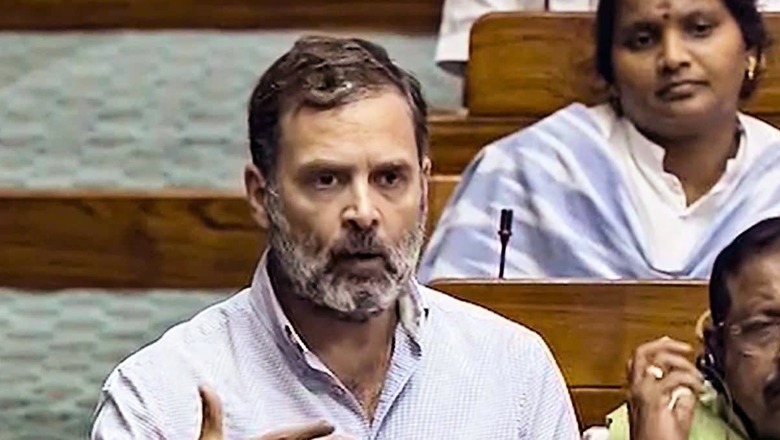
views
Bringing caste issues into the civil service, especially into the functioning of the Indian Administrative Service (IAS), and mentioning some numbers to present a certain picture was ‘unnecessary’, ‘insensible’ and ‘misleading’ — This is what civil service officers, both retired and serving at the Centre, told News18.
The senior bureaucrats were referring to Congress MP Rahul Gandhi’s statement in Parliament on Wednesday where the leader expressed ‘shock’ over the numbers which say that of 90 secretaries serving in the central government, only three belong to the OBC community.
Apart from the political slugfest over Gandhi’s comment and his act of dragging the civil service into the row, senior officers claim that his statement about the administration ‘lacked’ research. A senior IAS officer serving in DoPT said the figures which Gandhi presented are ‘misleading’.
“The current batch of secretaries, the empanelled officers and the data about current postings are generally related to batches which came in or before 1992. There were reserved categories for SC and ST, but not OBC. The OBC classification into All India Service (AIS) came only post 1995 following the court verdict, after the reports by Kalelkar commission and Mandal commission were analysed, and data of National Sample Survey Organisation was taken into account. Anyone who understands the service and the progression of the service knows how the batch system works in gaining seniority,” said the IAS officer.
“The empanelment is just about electing officers to be eligible for some positions. Empanelment never ensures posting or a position so it is not true that officers from reserved categories don’t get empanelled. Many times, officers get empanelment but don’t get postings and many times, they refuse to come to the Centre from the state. There are multiple factors,” he added.
Explaining the process further, the senior IAS officer said: “The postings and promotions are generally by merit, even though the government always promotes at least 20 per cent of reserved categories conventionally. But there is no formal rule related to promotion or posting for reserved categories. The reservation comes to work only during recruitment.”
Multiple Factors But No Discrimination
Presenting a counter-debate to Gandhi’s comment, BJP chief JP Nadda on Thursday said the OBC categorisation came post the court verdict in 1992 and that is why the batches of IAS officers, who joined services post 1992, will only be eligible for secretary position this year.
However, there are other technical and intricate details about the service, reservation and the categorisation of SC, ST, and OBC.
Starting from 2002 to 2022, across several Parliament sessions — including once in 2011, 2014, 2015, 2019, 2021 and latest in 2022 — the ministers concerned of DoPT (Department of Personnel and Training) keep providing statistics about the caste data in All India Services and under the central government staffing scheme which includes IAS, IPS and IFoS officers.
In Parliament this year, minister of state Jitendra Singh (DoPT) said in a written reply: “Out of a total of 322 officers currently holding the posts of Joint Secretaries and Secretaries under Central Staffing Scheme in different Ministries/Departments, 16, 13, 39 and 254 belong to SC, ST, Other Backward Classes (OBC) and General category, respectively.”
For context and comparison, one can have a look at the government data of 2011. In 2011, four, two and 15 ST officers were posted as secretaries, additional secretaries and joint secretaries. There was no SC officer in the secretary rank, two SC officers were at additional secretary rank while 31 officers were at the joint secretary rank. News18 has all relevant documents related to the statistics mentioned here.
Another senior officer serving in the central government, who deals with service matters, said there are multiple factors at play. “Age is one of them. The age limit for reserved category has now been extended to 36 or 37, while earlier it used to be 30. For general category, it earlier used to be around 26 or 27 and it has become 30. So, clearly, the officers from reserved categories join service late and retire before reaching the secretary scale at that time.”
He added: “However, we have many officers from reserved categories serving as joint and additional secretaries currently. They will soon be promoted as secretaries. So, there has been no discrimination.”
‘Unfair to Bring Caste in Administration’
The bureaucrats are of the opinion that bringing the caste factor into administration is “unfair” and “irresponsible”.
Some senior ministers may have certain preferences for upper castes but those preferences do not always lead to harassment for officers belonging to OBC categories, said Anil Swarup, former coal secretary.
“In administration, the caste colour is not seen generally. There can be some cases where officers may have claimed caste-related harassment, but these are stray cases. It is unfair to bring caste into administration because the promotions and posting are merit-based and depend on multiple other factors. The officers of general category also face multiple issues. No one targets a particular caste,” he added. Swarup has written a trilogy on civil services, which includes his experiences and issues related to the service.
KM Chandrasekhar, former cabinet secretary, said caste was never a determining factor for empanelment to posting even during the 90s. “The reserved categories matter only during recruitment. Later, all officers are the same and promotions and postings happen based on their work and merit. We never analysed castes. It never mattered in the progression of service. Such statements are not responsible,” said Chandrasekhar who served as cabinet secretary in former prime minister Manmohan Singh’s government.




















Comments
0 comment